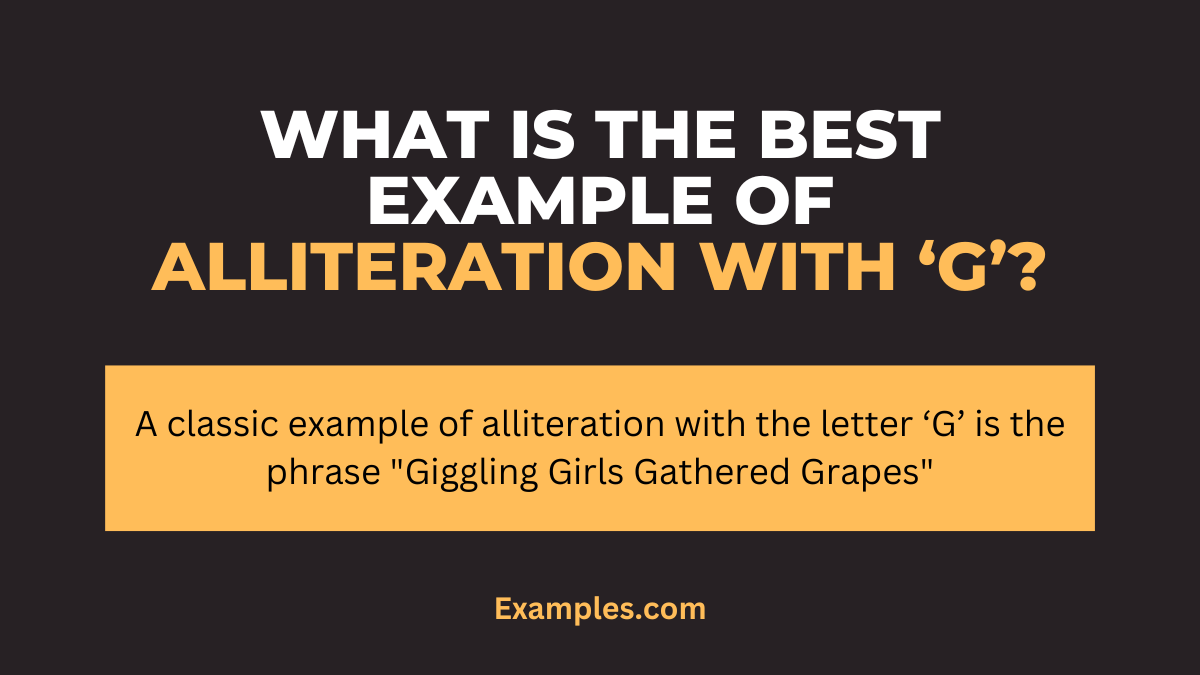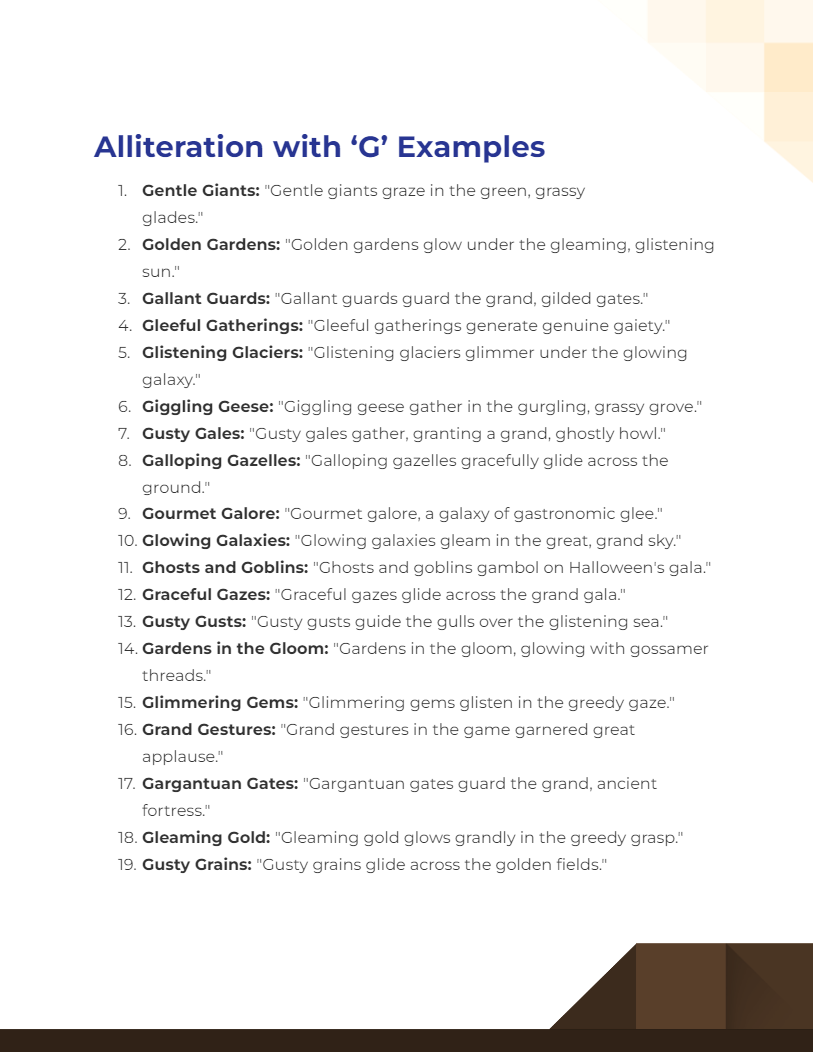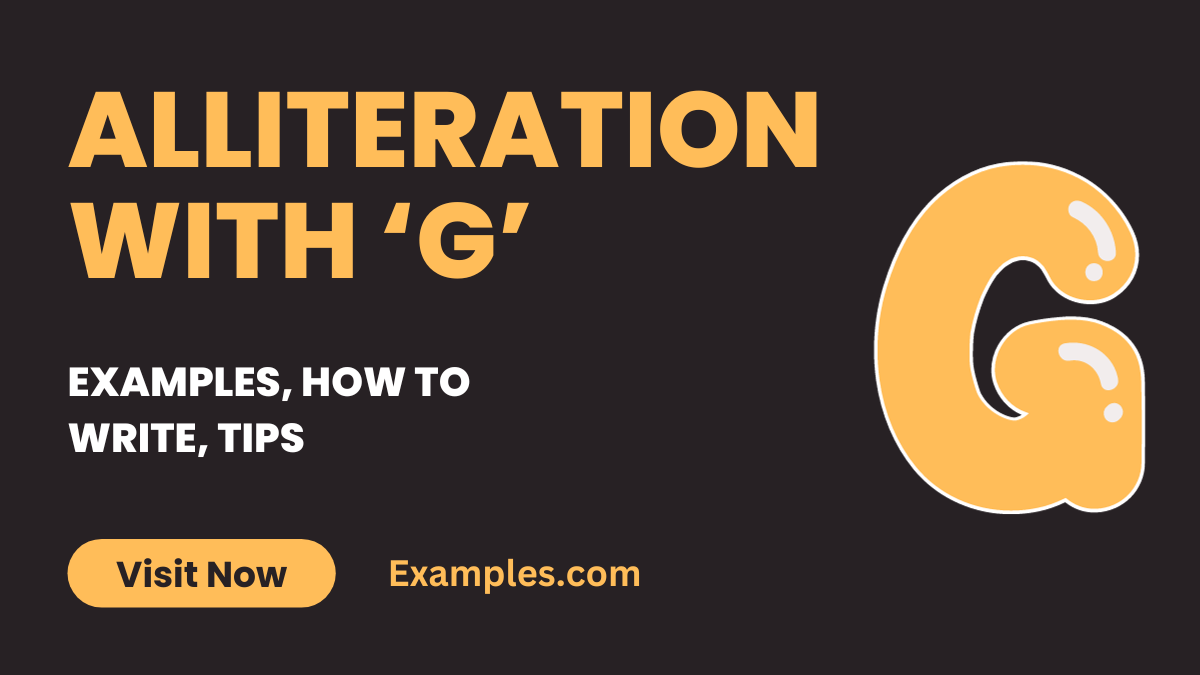Alliteration with G
Alliteration with ‘G’ is a poetic device that involves the repetition of the ‘G’ sound at the beginning of words in a phrase or sentence. It’s a stylistic approach used to add rhythm, focus, and musicality to writing. This technique is often found in literature, poetry, and even in everyday language, enhancing the auditory appeal of language. Mastering alliteration with ‘G’ involves selecting words that start with the ‘G’ sound and strategically placing them to create a memorable, sonorous effect. This can be particularly effective in creating mood, emphasizing certain points, or simply making language more engaging and playful. Tips for crafting such alliterations and assonance include focusing on word choice, considering the context, and practicing the sound pattern to achieve the desired effect.
Download Alliteration with 'G' Examples
Download Alliteration with 'A' to 'Z' Examples
What is the Best Example of Alliteration with ‘G’?

Example: A classic example of alliteration with the letter ‘G’ is the phrase “Giggling Girls Gathered Grapes”
Meaning: Alliteration is a literary device that involves the repetition of consonant sounds at the beginning of words in a phrase or sentence. In the example “Giggling Girls Gathered Grapes,” the consonant ‘G’ is repeated in each word’s initial sound. This repetition creates a musical quality and makes the phrase more memorable. Easy Alliteration is often used in literature, poetry, and advertising to add emphasis, rhythm, and poetic beauty to language. It can also help convey a playful or whimsical tone in writing.
20 Alliteration with ‘G’ Examples

Download Alliteration with 'G' Examples in PDF
Alliteration with the letter ‘G’ garners a unique blend of grace and gaiety in language. The ‘G’ sound, whether soft as in ‘giant’ or hard as in ‘gate’, offers a diverse range of auditory experiences. It can impart a sense of grandeur, gentleness, or glee to phrases and sentences, making them more captivating and memorable. Below are 20 unique examples of alliteration with ‘G’, each complemented by a alliteration in rhyme title that reflects the essence of the phrase.
- Gentle Giants: “Gentle giants graze in the green, grassy glades.”
- Golden Gardens: “Golden gardens glow under the gleaming, glistening sun.”
- Gallant Guards: “Gallant guards guard the grand, gilded gates.”
- Gleeful Gatherings: “Gleeful gatherings generate genuine gaiety.”
- Glistening Glaciers: “Glistening glaciers glimmer under the glowing galaxy.”
- Giggling Geese: “Giggling geese gather in the gurgling, grassy grove.”
- Gusty Gales: “Gusty gales gather, granting a grand, ghostly howl.”
- Galloping Gazelles: “Galloping gazelles gracefully glide across the ground.”
- Gourmet Galore: “Gourmet galore, a galaxy of gastronomic glee.”
- Glowing Galaxies: “Glowing galaxies gleam in the great, grand sky.”
- Ghosts and Goblins: “Ghosts and goblins gambol on Halloween’s gala.”
- Graceful Gazes: “Graceful gazes glide across the grand gala.”
- Gusty Gusts: “Gusty gusts guide the gulls over the glistening sea.”
- Gardens in the Gloom: “Gardens in the gloom, glowing with gossamer threads.”
- Glimmering Gems: “Glimmering gems glisten in the greedy gaze.”
- Grand Gestures: “Grand gestures in the game garnered great applause.”
- Gargantuan Gates: “Gargantuan gates guard the grand, ancient fortress.”
- Gleaming Gold: “Gleaming gold glows grandly in the greedy grasp.”
- Gusty Grains: “Gusty grains glide across the golden fields.”
- Gallivanting Globetrotters: “Gallivanting globetrotters glean gems of wisdom.”
Alliteration Sentence Examples with ‘G’
Alliteration sentences with ‘G’ often carry a rhythmic gravity or a sense of gaiety, using the ‘G’ sound to create memorable and sometimes whimsical phrases. Whether employing the hard or soft ‘G’ sound, these sentences can enhance the lyrical quality of writing. Here are three examples:
- “Glowing green gardens granted serenity and grace.”
- “Greg’s great golden retriever gaily galloped across the grass.”
- “Gargantuan grapes grew in the gorgeous, sunlit grove.”
Alliteration Examples with ‘G’ Name
Using names that start with ‘G’ in alliteration can add a personal, relatable touch to phrases, making them more engaging. Here are three examples:
- “Grace’s garden glowed with geraniums and gladioli.”
- “George’s grand gestures garnered generous applause.”
- “Gina’s giggles grew as the goofy games began.”
Alliteration Examples with ‘G’ Words
Alliteration with ‘G’ words creates a distinct sound that can range from gentle to grandiose. These examples showcase the versatility of the ‘G’ sound in creating engaging and rhythmical phrases for hard alliteration. Here are three examples:
- “Gilded gates guarded the grand, ancient grove.”
- “Gleeful guests gathered, gossiping and giggling.”
- “Ghosts glide gracefully through the gloomy graveyard.”
Alliteration Examples with ‘G’ Sound
The ‘G’ sound in alliteration can produce a variety of effects, from playful and light to serious and impactful. These examples demonstrate the different ways the ‘G’ sound can be employed in alliterative songs structure. Here are three examples:
- “Galloping horses generated a grand, ground-shaking sound.”
- “Glistening dew drops gathered on the green grass.”
- “Gentle gusts of wind guided the gliding gulls.”
Alliteration Examples with ‘G’ for Kids
Alliteration for kids involves simple, fun phrases that are easy to remember and recite. These examples can be particularly enjoyable for young learners. Here are three examples:
- “Gary the goat gobbled green grapes in the garden.”
- “Gloria’s giggly geese played games in the golden grass.”
- “Gregory the giraffe grazed in the great green meadow.”
Alliteration Beginning with ‘G’
Alliteration beginning with ‘G’ sets a distinctive tone and rhythm in a phrase, often creating a memorable impact. Here are three examples:
- “Glamorous gowns graced the gala, glittering grandly.”
- “Grumpy gnomes guarded the golden garden.”
- “Gleeful children played games in the glowing garden.”
How to Write Alliteration with ‘G’?
Writing alliteration answers with the letter ‘G’ involves using words that start with the ‘G’ sound in close proximity within sentences or phrases. This consonantal alliteration in poem can add a lyrical, rhythmic quality to writing, whether you use the soft ‘G’ (as in ‘giant’) or the hard ‘G’ (as in ‘gate’). Here’s how to craft effective alliteration with ‘G’:
- Understand the ‘G’ Sound: Recognize the two distinct sounds of ‘G’ – the soft and the hard sounds. The choice of sound affects the tone and flow of your alliteration.
- Select a Theme: Choose a theme or subject for your sentence or piece. This helps in finding ‘G’ words that are relevant and coherent with your topic.
- Brainstorm ‘G’ Words: Compile a list of words starting with the ‘G’ sound. A thesaurus can be useful for finding a variety of words, including adjectives, nouns, and verbs.
- Construct Your Sentence: Arrange the ‘G’ words to form a sentence or phrase. Aim for a natural and fluid structure that sounds rhythmic when spoken.
- Read Aloud for Rhythm: The effectiveness of alliteration is often best judged audibly. Read your sentence aloud to ensure it has a pleasing rhythm and flow.
- Revise for Impact and Clarity: Edit your sentence for maximum impact. Ensure that the alliteration enhances the message without compromising clarity.
- Incorporate into Your Writing: Seamlessly integrate your alliterative phrase into your larger text, whether it’s a poem, story, or an essay, to add stylistic flair.
Tips for Using Alliteration with ‘G’
- Use Sparingly: Alliteration should enhance, not overwhelm, your writing. Use it to highlight important points or to add a poetic touch but avoid overdoing it.
- Ensure Clarity: While alliteration adds style, clarity should always be your priority. Your sentence should remain clear and easy to understand.
- Vary Word Lengths and Types: Mix short and long ‘G’ words, as well as different types (nouns, verbs, adjectives), for a more interesting and varied rhythm.
- Consider the Mood: The ‘G’ sound can be gentle or bold. Choose words that align with the mood and tone you want to convey in your writing.
- Test the Sound: Read your work aloud to catch the rhythm and flow. The auditory impact of alliteration is crucial to its effectiveness.
- Avoid Forced Repetition: Ensure that the repetition of ‘G’ sounds natural and not forced. Forced alliteration can detract from the reader’s experience.
- Explore Different Contexts: Try using alliteration in various forms of writing, from creative to academic, to understand its effect on your work.
By following these guidelines, you can effectively use alliteration figurative language to add a distinctive, rhythmic quality to your writing, making it more engaging and enjoyable for your audience.
What is the Alliteration with ‘G’ for Students?
Alliteration for students refers to the repetition of the initial ‘G’ sound in adjacent or closely connected words, used as an educational tool. This technique is particularly valuable in enhancing students’ phonetic awareness, enriching their vocabulary, and introducing them to literary devices. In younger students, it aids in language development and learning pronunciation, while for older students, it serves as a creative element in writing and poetry. For example, phrases like “Glorious gardens grow golden grapes” or “Gregory the goat grazed in the green grass” can make language lessons more engaging and memorable.
What is the Effect of ‘G’ Letter in Alliteration?
The effect of the ‘G’ letter in alliteration is to create a rhythmic and often robust sound that can add emphasis and texture to language. The ‘G’ sound can be hard (as in ‘goat’) or soft (as in ‘giraffe’), offering versatility in its use. Hard ‘G’ alliteration lends a stronger, more pronounced beat to the text, often used to convey authority or emphasis. In contrast, soft ‘G’ alliteration imparts a gentler, more fluid sound, suitable for creating a softer or whimsical tone. This diversity makes famous alliteration a popular choice in poetry, prose, and advertising for its ability to add depth and character to language.
What is the Alliteration ‘G’ Type of?
Alliteration with the letter ‘G’ is a type of consonantal alliteration. This literary device involves the repetition of the ‘G’ consonant sound at the beginning of adjacent or closely connected words. It’s a common and effective tool used across various forms of writing, notably in poetry, prose, and persuasive writing, like advertising. The Great Alliteration can create different effects based on whether the ‘G’ sound is hard or soft, allowing writers to play with the tone and rhythm of their text. It’s valued for its ability to add a rhythmic quality, emphasize certain points, and enhance the overall auditory appeal of the language.


